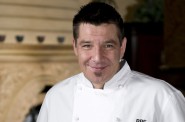Chef Gregg DesRosier Loves Ramen
And he’s turned Tochi into the city’s only restaurant dedicated to it.
Campers, backpackers, college students, harried homemakers — we’ve all thrown a package of ramen into a pot of boiling water, added the flavor packet, and called it a meal. It’s fast, filling, tasty, and so cheap that at one time you could buy ten for $1.00.
At Tochi in Shorewood, Chef Gregg DesRosier has taken ramen and used it as a base to created dishes worthy of multi-star restaurants. His passion for that uniquely basic combination of noodles, protein, and broth infuses every dish on the menu. As DesRosier says, “The spirit of the dish goes into the process of making it.” He not only builds his menu around ramen, but wants to dedicate himself to exploring that quintessential comfort food: “This is probably what I’m going to do with the rest of my life,” he says. “I want to study one discipline.”
At Tochi, Milwaukee’s only dedicated ramen restaurant, DesRosier offers two authentic, classic ramens, the Tochi with pork-based miso broth and the Shoyu, made with soy-based broth. “Then,” he says, “I get to have fun with the rest.”
I sampled the bacon and egg mazeman, made with more noodles than the classic ramen, and decided I could eat it for breakfast every day. Sausage lovers will want to try Wisconsin ramen with beer, brats and caramelized onions. “I want to make ramen accessible to people who have never had it,” says DesRosier. “In America you can build and make it into whatever you want.”
DesRosier knew he wanted to work with ramen the first time he tasted the real thing at a restaurant in Chicago that specialized in it. “As a chef,” he notes, “I could taste how much work went into it.” At the time, the restaurant at 2107 East Capitol Drive was the Anaba Tea Room and DesRosier was the chef. After his epiphany, he continued to head up the kitchen at Anaba while he experimented at home perfecting a new menu. “The hardest part,” he says, “was sourcing all the ingredients. It took two years to get the fish sauce I use. Even though I had never tasted that particular fish sauce, I knew it was what I wanted.”
This is a chef who learned his trade in the kitchen, not at culinary school. He started his career at a Greek restaurant in Milwaukee because a neighbor needed some help. Then he worked at a restaurant in West Bend and followed that with a stint at the Audubon Inn in Mayville. His last stop before landing at the Anaba Tea Room 13 years ago was the Bristlecone Pines Golf Club in Hartland where he was the Executive Chef. On January 17, one year ago, he put the tea room behind him, added an image of a fire-breathing dragon on a wall, and renamed the restaurant Tochi. Sadly, two weeks before Tochi opened, his father died. “He is the reason I am who I am,” DesRosier says.
He doesn’t look like a chef; when we met DesRosier suggested someone who’d just returned from a walk in the woods in his well-worn jeans, nondescript shirt and wool cap. “We don’t do chef coats here,” he says. “We have an ego-less kitchen. I took all the pretensions out of it.”
It makes sense to run a kitchen that way because as he explained, “Ramen has always been associated with laborers. In Japan they eat it for lunch and that meal will stay with them for the rest of the day.”
When I asked, “How do you do that, get the flavor of the broth into the noodle?” he replies, “You have to eat it quickly so the broth flavor will stick to the noodles.”
When I mention that I had to slurp when I sampled the Tochi ramen DesRosier says, “I can tell by looking at the customers if they’ve eaten ramen before. Look at the two men at the table behind you. They know how to eat ramen.”
They sat, heads bent low over their bowls, and used chopsticks to lift the noodles. Then, silently, without the hint of a slurp, they emptied their bowls. They ate quickly, just as chef DesRosier said they should, to keep the flavor of the broth adhered to the noodles.
I learned that just as ramen is always layered, there’s also a proper way to eat it starting with the broth, then the noodles, followed by the protein. The flavors should be pure. “The less I have to manipulate a food, the better I like it. I let the food speak to me,” says DesRosier.
He gets his inspiration from getting out of the kitchen, or “getting away from the work bubble,” as he puts it. DesRosier will leave that bubble far behind sometime this year when he travels to Viet Nam, buys a motorcycle and journeys into the center of the country to learn how the locals use what’s available. He wants to know how dishes are developed in remote areas. “It’s a personal journey for myself. I’ll discover some new ingredients and learn new techniques. Balance and technique are the fundamentals in cooking and that’s what ramen is all about.”
DesRosier, in turn, will pass that knowledge on. As a mentor to his young staff he says, “I want to get input from them. I like working with creative young people. Their excitement keeps me young.”
Chef Chat
-
How I Became a Cheesehead
 Mar 3rd, 2017 by Cari Taylor-Carlson
Mar 3rd, 2017 by Cari Taylor-Carlson
-
How Zach Espinosa Became a Master Chef
 Aug 30th, 2016 by Cari Taylor-Carlson
Aug 30th, 2016 by Cari Taylor-Carlson
-
Brian Frakes Juggles Four Kitchens
 Aug 1st, 2016 by Cari Taylor-Carlson
Aug 1st, 2016 by Cari Taylor-Carlson























This is a very good article about a chef who knows what it is to create great ramen!! I have traveled Asia and the Pacific where noodles are the staple; to find a place in Shorewood, Wisconsin that serves up authentic ramen is remarkable.